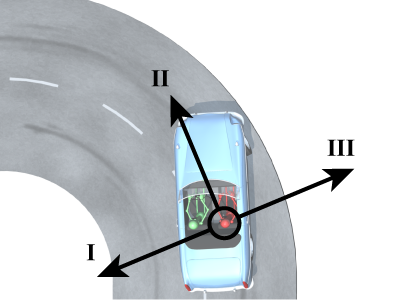
- At a single moment in time, a passenger (circled) sits in the right-hand seat of a sports car. The car is turning sharply to the left, and the passenger feels as if she were being pushed against the door to her right.
- Which of the three labeled vectors (I, II, or III) shows the direction of the passenger’s velocity?
- Which of the three labeled vectors (I, II, or III) shows the direction of the passenger’s acceleration?
- Which of the three labeled vectors (I, II, or III) shows the direction of the centripetal force that acts upon the passenger?
- Research the history of the discovery of the law of universal gravitation on the Internet or at a library. Prepare a two-minute oral report using three vocabulary words from this chapter. Make sure to include when and where the law was published and by whom.
- Write the equation for the law of universal gravitation in words. Describe how the magnitude of the force changes as objects move closer and farther from one another.
- Using the law of universal gravitation, explain why we clearly feel the gravity of Earth but don’t notice the gravitational pull of the Sun, even though the Sun is much more massive than the Earth.
- When Newton first proposed the idea of the law of universal gravitation, a man named Robert Hooke claimed that Newton stole the idea from him. Research Robert Hooke and his main contributions to science. Write a short report on what you learned. Follow a standard format for citations in your paper.
| | - Astronauts conduct microgravity experiments aboard the International Space Station orbiting at an altitude of 416 km above Earth’s surface.
- At this altitude what is the relative strength of Earth’s gravity compared to its strength at the surface?
- Explain how astronauts can be virtually “weightless” even when they feel gravity nearly equal to that on the surface.
 The law of universal gravitation determines your weight on Earth’s surface. To an excellent approximation, we can assume Earth’s mass is all concentrated at the planet's center. Your weight is then determined by your mass, Earth’s mass, and Earth’s radius. The law of universal gravitation determines your weight on Earth’s surface. To an excellent approximation, we can assume Earth’s mass is all concentrated at the planet's center. Your weight is then determined by your mass, Earth’s mass, and Earth’s radius.
- Suppose the Earth shrank to three-quarters of its present-day radius but retained all of its mass. Would your weight increase, decrease, or stay the same?
- Now suppose the Earth somehow got rid of one-third of its mass but maintained the same radius. Would your weight increase, decrease, or stay the same?
- Suppose the Earth’s mass doubled and its radius doubled, too. Would your weight increase, decrease, or stay the same?
 A geostationary satellite is a spacecraft that remains above a single spot on Earth, such as a city that receives its radio signals. Geostationary satellites orbit Earth at an altitude of roughly 36,000 km (that is, 42,300 km from the center of our planet). A geostationary satellite is a spacecraft that remains above a single spot on Earth, such as a city that receives its radio signals. Geostationary satellites orbit Earth at an altitude of roughly 36,000 km (that is, 42,300 km from the center of our planet).
- Suppose that Earth’s day length was 12 hours (rather than 24 hours) at our time in history. Would a geostationary satellite’s altitude be higher than, lower than, or equal to 36,000 km?
- Suppose that Earth had formed, nearly five billion years ago, with twice as much mass. Would a geostationary satellite’s altitude be higher than, lower than, or equal to 36,000 km?
 Consider Jupiter moving in its elliptical orbit around the Sun according to Kepler’s laws. If Jupiter were suddenly to become twice as massive, then the gravitational force the Sun exerts on Jupiter would double, according to the law of universal gravitation. How would this increase in force change Jupiter’s orbit? Consider Jupiter moving in its elliptical orbit around the Sun according to Kepler’s laws. If Jupiter were suddenly to become twice as massive, then the gravitational force the Sun exerts on Jupiter would double, according to the law of universal gravitation. How would this increase in force change Jupiter’s orbit?
|

